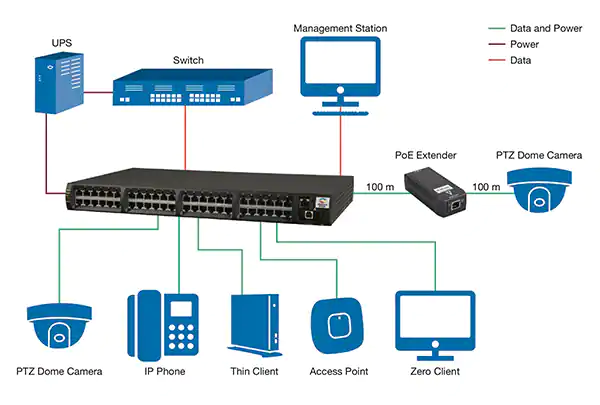Power over Ethernet (PoE) is a technology that allows Ethernet cables to carry power and data simultaneously over the same network cable. PoE eliminates the need for separate data and power cables by utilizing the same Cat 5e, Cat 6, Cat 6A, and Cat 8 Ethernet cables.
How Does PoE Work?
PoE was introduced to offer support to wireless devices by connecting to LAN networks. The Ethernet cable is made up of different wires that transmit data or power. The power-carrying wire is kept separate to avoid signal transfer during data transmission.
In the past, a security camera, for example, required both a power and a network connection using two different cables. However, with PoE-enabled devices, the camera will receive power and data connections using a single cable. This reduces the connections required by half!
Benefits of PoE in Outdoor Settings
Devices such as cameras, phones, routers, switches, extenders, injectors, and more can leverage PoE to eliminate the need for additional power access points. Choosing PoE has the following benefits:
-
Reduced Costs: PoE allows you to eliminate the need for separate power cables, reducing the time and cost associated with installing electrical cables by half. Further, choosing PoE eliminates the need for AC outlets, professional electrician, and maintenance expenses during installation
-
Speedy Installation: PoE simply requires you to plug in the network cable to the proper device to function well.
-
Increased Flexibility: Because devices using PoE do not rely on proximity to electrical outlets, they can be positioned where they are most needed and can be repositioned easily when required. This is convenient as AC outlets may be unavailable or cannot be installed in an outdoor setting.
-
Enhanced Safety: PoE uses low wattage power to perform tasks and, therefore, presents low electrical hazard risks. PoE also has built-in safety protocols to protect network equipment from incorrect installation, overload, or short circuits.
-
High Scalability: New devices can be added to the network as needed.
Unlike traditional communications such as RS232 (point-to-point) or RS485 (multi-drop), which are slow and inflexible, PoE is an easy installation, low maintenance, and more cost-effective choice.
PoE Protection in an Outdoor Environment
When installing devices in an outdoor PoE network, you need to consider the following:
-
Dust and Water protection. The IP Code is used to classify and rate the rate of water and solid protection for electrical devices and mechanical casings with enclosures. IP69 offers the highest protection against dust and jetting water. The first digit (6) indicates the level of protection against dust, while the last digit (9) indicates protection against jetting water.
-
NEMA Enclosure Type. The degree of protection a device’s casing offers against corrosion. It ranges from 1 to 4X.
-
UV Protection. Devices that are 60950-22 certified are sufficiently resistant to degradation by sun exposure and have been tested and approved for outdoor use.
-
Surge and Lightning Protection. Surges can damage the internal circuitry of endpoint devices and even reach and damage expensive indoor devices. To protect your PoE devices from outdoor surges, install two surge protectors per device.
Flexible Implementation with PoE
PoE offers flexibility in placement. In most cases, electrical outlets are not available in outdoor areas; therefore, PoE relieves this barrier and allows data power connection via a standard Ethernet cable. In addition, PoE offers ‘plug-and-play’ deployment. Due to their simplified installation, PoE eliminates the need for a professional electrician and reduces the time spent on installation. You only need to connect the Ethernet cable to the right device. PoE offers flexibility through scaling. New devices can be added to an existing PoE network seamlessly.
What PDs Comprise An Outdoor Network
A Powered Device(PD) is a network device that is powered by PoE. Examples of PDs in an outdoor network include:
-
Outdoor kiosks
-
Wireless access points
-
Outdoor advertising, such as digital signage
-
Outdoor PoE IP security cameras
-
Outdoor lighting, such as string lights, pathway and security lighting, outdoor fixtures, etc
-
Display screens used in transportation, museums, etc.
Types of PoE Devices for Outdoor Use
PoE devices used in outdoor and harsh deployment should meet the following criteria:
-
Durable metal housing
-
Wide operating temperature range from –40 to 75 °C
-
IP67 or higher waterproof rated
The following are the most common PSE (Power Sourcing Equipment) and PD (Powered Devices) that meet the requirements for outdoor use:
-
Outdoor PoE Injector: An injector, also known as midspan, is used to connect a PoE-enabled network device to a non-PoE LAN switch port. An injector can allow you to supply PoE to the edge PoE devices over a single cable, relieving the need for a new switch.
-
Managed Outdoor PoE Switch: Similar to regular switches, but they can be powered by PoE PSE and can transmit to edge PoE devices.
-
Outdoor PoE Extender: They help repeat and extend PoE or Ethernet over long distances.
Other popular devices include IP security cameras powered with PoE technology, Wireless access points (WAPs), and more.
What Is Industrial Hardening?
Power over Ethernet devices can be categorized into two; commercial and hardened PoE. Commercial PoE can be an ideal choice due to its reliability and low cost. However, these devices are less suited for harsh conditions and are ideal for office and indoor environments.
Their hardened counterparts, however, are well suited for ‘rugged’ and harsh environments with extreme fluctuations in temperature, dirt, and moisture. They are built to withstand harsh temperatures of -40 °F (-40 °C) to 167 °F (+75 °C) or noisy environments subject to vibrations. Hardened PoE is designed to meet the challenges of an outdoor environment and can be installed without unnecessary climate-controlled enclosures. Hardened PoE devices can be applied in surveillance systems, coal mining, factory automation, or traffic intersection monitoring.
To protect outdoor PoE circuits from current overload, placing a time-delay fuse on each I/O line or gas discharge tube across the I/O line is recommended. A gas discharge tube protects against lightning and can absorb up to 1000A of current surges.



































